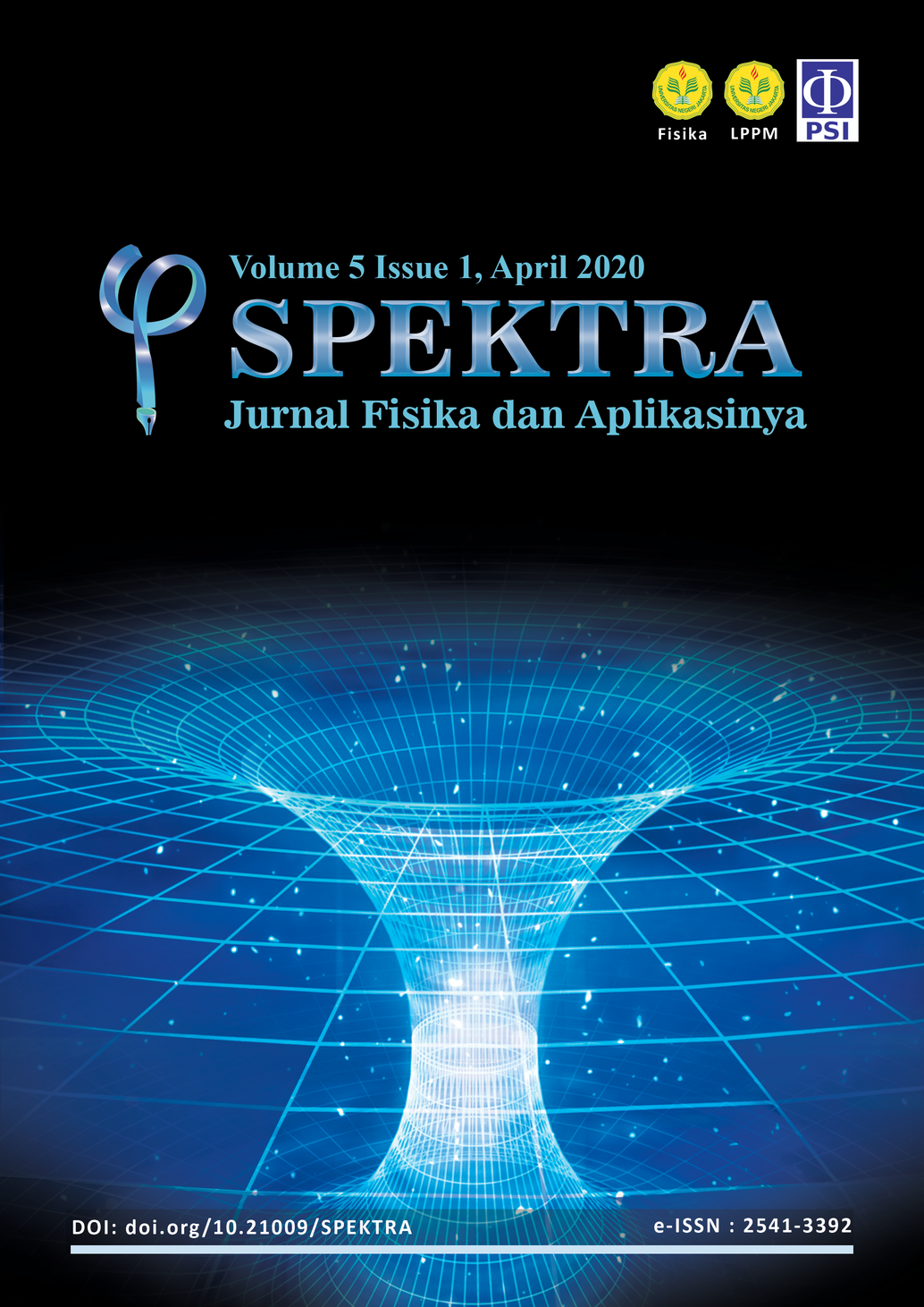SURFACE MORPHOLOGY OF SPUTTERED TITANIUM-ALUMINUM-NITRIDE COATINGS
DOI:
https://doi.org/10.21009/SPEKTRA.051.09Keywords:
TiAlN coating, surface morphology, sputtering, substrate bias, nitrogen flow rateAbstract
A study on the surface morphology of sputtered TiAlN coatings is presented. The coatings were deposited by DC magnetron sputtering on tungsten carbide insert tools. The surface morphology was characterized by using Atomic Force Microscopy (AFM), and the surface roughness was indicated by RMS roughness value. It was observed that the TiAlN coating surface morphology was rough as the negative substrate bias and nitrogen flow rate are increased. The evolution of the sputtered TiAlN coatings surface morphology was due to the competition between particle diffusion and re-scattering effect during the sputtering process. At high negative substrate bias and nitrogen flow rate, the re-scattering effect was prominent, leading to the high roughness of the sputtered TiAlN coating surface.
References
[2] Z. Geng et al., “Tribological behavior of patterned TiAlN coatings at elevated temperatures,” Surface & Coatings Technology, 2019.
[3] H. Elmkhah et al., “Surface characteristics for the Ti-Al-N coatings deposited by high power impulse magnetron sputtering technique at the different bias voltages,” Journal of Alloy and Compounds, 2016.
[4] M. Wang et al., “Surface morphology and tribological properties of DC sputtered nanoscale multilayered TiAlN/CNx coatings,” Tribology International, 2014.
[5] T. Takahashi et al., “Surface Morphology of TiN Films Reactively Deposited by Bias Sputtering,” Vacuum 2000, vol. 59.
[6] O. Zywitzki et al., “Structure of Superhard Nanocrystalline (Ti,Al)N Layers Deposited by Reactive Pulsed Magnetron,” Surface and Coating Technology, 2006.
[7] K. Chakrabarti et al., “Effects of Nitrogen Flow Rates on the Growth Morphology of TiAlN Films Prepared by an RF-Reactive Sputtering Technique,” Thin Solid Films, 2002.
[8] J. Musil and H. Hruby, “Superhard Nanocomposite Ti1-xAlxN Films Prepared by Magnetron Sputtering,” Thin Solid Films, 2000.
[9] W. Liu et al., “Preparation and properties of TiAlN coatings on silicon nitride ceramic cutting tools,” Ceramics International, 2018.
[10] W. Zhou et al., “A comparative research on TiAlN coatings reactively sputtered from powder and from smelting TiAl targets at various nitrogen flow rates,” Applied Surface Science, 2014.
[11] E. Budi, M. Mohd. Razali and A. R. Md. Nizam, “Composition, morphology and mechanical properties of sputtered TiAlN coating,” AIP Conf. Proc., 2014.
[12] E. Budi, M. Mohd. Razali and A. R. Md. Nizam, “Effect of Reactive Sputtering Parameters on TiAlN Nanocoating Structure and Morphology,” AIP Conf. Proc., 2010.
[13] K. Chu, P.W. Shum and Y.G. Shen, “Substrate Bias Effects on Mechanical and Tribological Properties of Substitutional Solid Solution (Ti,Al)N Films Prepared by Reactive Magnetron Sputtering,” Materials Science and Engineering B, 2006.
[14] A. K. Chu et al., “Influences of Bias Voltage on the Crystallographic Orientation of AlN Thin Films Prepared by Long-Distance Magnetron Sputtering,” Thin Solid Films, 2003.
[15] H. Oettel, R. Wiedemann and S. Preiβler, “Residual Stresses in Nitride Hard Coatings Prepared by Magnetron Sputtering and Arc Evaporation,” Surface and Coatings Technology, 1995.
[16] C. He et al., “Microstructure and mechanical properties of reactive sputtered nanocrystalline (Ti,Al)N films,” Thin Solid Films, 2015.
[17] F. Burmeister et al., “Investigation of Structured TiAlN- and TiO2-Coatings with Moth-Eye-Like Surface Morphologies,” Surface & Coatings Technology, 2005.
[18] S. K. Wu, H. C. Lin and P. L. Liu, “An Investigation of Unbalanced-Magnetron Sputtered TiAlN Films on SKH51 High-Speed Steel,” Surface and Coatings Technology, 2000.
[19] H. Klostermann et al., “Nanocomposite Oxide and Nitride Hard Coatings Produced by Pulse Magnetron Sputtering,” Surface Coating Technology, 2005.
[20] A. R. Md. Nizam et al., “Effect of PVD process parameters on TiAlN coatings roughness,” Journal of Mechanical Engineering and Technology, 2010.
[21] Z. L. Liu et al., “Kinetic Monte Carlo Simulation of Deposition of Energetic Copper Atoms on a Cu(001) Substrate,” Journal of Physic D: Applied Physics, 2005.
Downloads
Published
How to Cite
Issue
Section
License
SPEKTRA: Jurnal Fisika dan Aplikasinya allow the author(s) to hold the copyright without restrictions and allow the author(s) to retain publishing rights without restrictions. SPEKTRA: Jurnal Fisika dan Aplikasinya CC-BY or an equivalent license as the optimal license for the publication, distribution, use, and reuse of scholarly work. In developing strategy and setting priorities, SPEKTRA: Jurnal Fisika dan Aplikasinya recognize that free access is better than priced access, libre access is better than free access, and libre under CC-BY or the equivalent is better than libre under more restrictive open licenses. We should achieve what we can when we can. We should not delay achieving free in order to achieve libre, and we should not stop with free when we can achieve libre.
 SPEKTRA: Jurnal Fisika dan Aplikasinya is licensed under a Creative Commons Attribution 4.0 International License.
SPEKTRA: Jurnal Fisika dan Aplikasinya is licensed under a Creative Commons Attribution 4.0 International License.
You are free to:
Share - copy and redistribute the material in any medium or format
Adapt - remix, transform, and build upon the material for any purpose, even commercially.
The licensor cannot revoke these freedoms as long as you follow the license terms.

 E-ISSN 2541-3392
E-ISSN 2541-3392  Focus & Scope
Focus & Scope  Editorial Team
Editorial Team  Reviewer Team
Reviewer Team  Author Guidelines
Author Guidelines  Article Template
Article Template  Author Fee
Author Fee  Publication Ethics
Publication Ethics  Plagiarism Policy
Plagiarism Policy  Open Access Policy
Open Access Policy  Peer Review Process
Peer Review Process  Retraction & Correction
Retraction & Correction  Licensing & Copyright
Licensing & Copyright  Archiving & Repository
Archiving & Repository  Contact
Contact  Mendeley
Mendeley 

